dancing with one another
The arts of Harmony Korine
Harmony Korine, filmmaker, painter, novelist and screenwriter, likes it when things go wrong. The world being what it is, that often happens on its own, but when necessary he is not averse to throwing a metaphoric grenade into the middle of his film set as a way of shaking things up. It is a method he calls “Mistakist” and it remains his most valued aesthetic principle. Whether directing a film, making a painting or writing a novel, his impulse is to look for a way to confuse the process. “I like not always having an endpoint and getting lost and trying to dig my way out of it,” he says in the following interview. “It has to do with this alchemical idea of putting different elements into a glass and documenting the explosion. There is a strange poetry to it.”
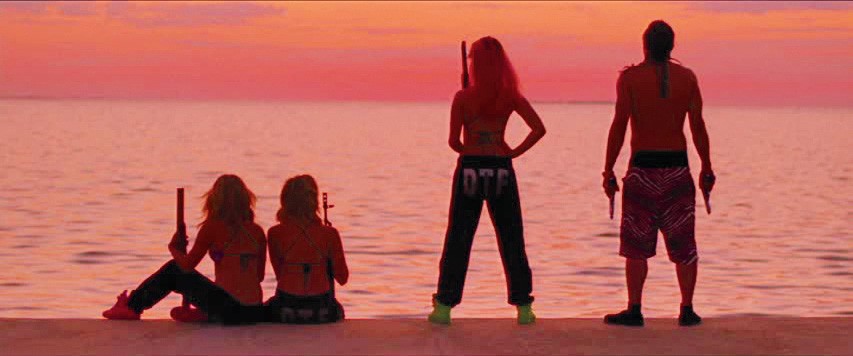
Spring Breakers, film still, 2012, 94 minutes.
Another way of talking about this strange poetry turns up in Mister Lonely, a 2007 film about a commune of celebrity impersonators, including Marilyn Monroe, Michael Jackson, Charlie Chaplin and the Pope. In one scene, the woman impersonating Britain’s Queen Elizabeth II delivers the kind of annual address royals give at Christmas. “We live through others,” she says with regal gravitas, “to keep the spirit of wonder alive.” The compulsion to keep that spirit alive is what engages Harmony Korine in all his work, and he is able to find it in the most unconventional places and people; in the beauty of a girl with Down Syndrome whose brother is pimping her to a pair of cat-hunters in a tornado-ravaged town; in the goofy rap song delivered by an albino black man; in the rapt attention of a schizophrenic man to a gospel preacher; in the lovesick devotion a mentally challenged girl holds for Patrick Swayze; and in the relentless nihilism of a trio of roving outcasts who perform acts of copulation with trash cans.
There are times when Korine seems barely able to keep the body of wonder on life support, and he will deliberately push hard in the direction of the condition’s darker dimensions. In an unfinished film project begun in 1999 called Fight Harm, he provoked people to get into fights with him and had the encounter filmed by friends. His intention was to make “the funniest film ever made, a cross between Buster Keaton and a snuff film.” The opponents he chose were large men and after six fights he had sustained a broken ankle, cracked ribs, a concussion, and a record of arrests. For his efforts, he had only 12 minutes of film. The wonder in this project is that he didn’t suffer more serious damage.

Installation view, Eden Rock–St. Barths, December 28, 2014 - January 31, 2015. Copyright Harmony Korine. Courtesy Gagosian Gallery. Photograph: Pierre Carreau.
As a way of countering the darkness evident in the films, there are moments of intermittent grace that appear as various forms of movement: a skater gliding on the ice; an awkward young ballerina; the simple act of walking through a golden landscape; a pas de trois with three gun-yielding young women wearing pink unicorn balaclavas, bikini tops and DTF sweatpants, dancing to a Britney Spears pop anthem. In Mister Lonely, the celebrity impersonators want “…to dance a different dance, to change our face and become who we want to be.” It is a transformation devoutly to be wished. In a phone call home, one of the springbreakers tells her mother she feels changed. “We’re different people now. We see things differently. More colours, more love,more understanding.” She and her girlfriend undergo a profound transformation before they return home; in this neon noire their break from reality becomes a dream of high-chroma violence. In Harmony Korine’s world there is no aesthetic hierarchy; everything affects every other thing. “None of the art I make is based on truth,” he says. “I’m trying to get to something that has to do with transcendence, or an energy, or some kind of fucked up vapour. I want it to work in a physical way.” This desirable physicality is especially evident in his paintings. They walk a visceral line between abstraction and figuration, between surface and depth, and between the drama of black and white and the radiance of colour. The paintings are squeegeed concoctions of house paint, ink, oil and collaged pieces of bubble wrap, plastic and paper, applied to canvas, safety blankets and felt. They move from vibrating ghostly creatures that seem to whirl about the surface, to surfaces that obscure the activity of figures beneath a dense architecture of stacked, coloured lines. “It’s repeating until things begin to happen, until the energy seems to come from below the surface,” the artist says, “until shadows start to become manifest.” The more he works, the more evidence there is that Harmony Korine’s manifest destiny is making him the alchemist of shadows.
The following interview was conducted by phone on January 5, 2015 to Miami, where Korine’s next film is in preproduction.
Border Crossings: When did you start painting?
Harmony Korine: I was painting in high school but I’d been making art for as long as I can remember. I made zines in Junior High in the late ’80s, the kind of thing that went hand-in-hand with skateboarding culture. I’d been painting the whole time but when I first moved to New York after I’d written Kids and met Larry Clark, I didn’t have any concept of how artists lived. I was around a group of artists and painters and it was a pretty amazing period. It was the same time I was putting out my first movies, in the mid-’90s and I’d had some shows with Patrick Painter and Andrea Rosen. So I was making art but I withdrew for some reason. Making art became a private thing and the films became a more public display.
You didn’t have any formal training in art did you?
No. At NYU, Michael St. John was my art teacher and his way of helping was to encourage a lot of my juvenile behaviour. It was an awful thing for me.
But in New York you were hanging out with Larry Clark who knew artists from California to New York. Did that change your conception of what an artist could be?
Sure, because I was around this amazing group of artists—Christopher Wool and Cady Noland and Larry. I was coming out of my teenage years, just a kid really, and I was going through their bookshelves and picking up on things.
What is it that drives you to the studio now as opposed to writing or working on a screenplay, or any of the other things that you do? You don’t seem to have hierarchies about art forms; a novel doesn’t seem any more important to you than a film or a painting.
There never were any levels or hierarchies. I liked making things. As early as I can remember, even as a kid, I always thought of everything affecting everything. I had a unified aesthetic or a singular vision and I would go from one to the other without really thinking that much about it. They were almost like moods; the books were connected to the art, which was connected to the films, which was connected to music, or whatever I was making. I was not trying to differentiate, or make sense of, or clarify their role with regard to one another. I was more interested in inventing as I went and acting on my own urges.
Do you still hold to that early sense that the art forms are integrated?
I feel pretty much the same as I did when I was a teenager. I never felt really comfortable being attached to any one world. I just liked being able to act as quickly as I could imagine something happening. I like to try to create things that are difficult for me to articulate. It’s more of a pull; sometimes you feel like writing, sometimes it’s painting and at other times it’s making films. But they’re all meant to dance with each other.
You’ve said the novel has evolved hundreds of times but film is still stuck in the birth canal. Is your film work an attempt to yank the kid out of the birth canal and get him on his feet?
I don’t really think about that. I probably said that about the novel when I was in my early 20s. Those aren’t the terms I would use today. What I’m trying now in film is very specific. It’s a specific language that has to do with some kind of sensory experience, closer to a drug experience or a total physical dimension. I want the movies to wash over you; to go through you in a way; to create a kind of sensory bombardment. I’ve been trying to get this idea of a liquid narrative, a free-form storytelling where time is exploded and colours become characters. It is something I’ve been feeling since I was a kid and I’m just now maybe starting to get on it.
The film that has the most liquidity, to use your measure of narrative intention, is Spring Breakers, both from a colour perspective and in the way the final sequence turns into a non-virtual video game. You’ve said that you don’t go back and look at your earlier films, but doesn’t each film set its own problem? So if it matters to you what you accomplished in, say, Gummo, doesn’t your next film have to go a step beyond?
It’s not a conscious thing; I don’t ever go back. It’s all in me, all those experiences and ideas and the things that worked and the ones that didn’t. So I don’t re-watch the films. For me the process is more forward-thinking. It’s a strong pull forward that has less to do with self-analysis and more to do with just wanting to fuck shit up.
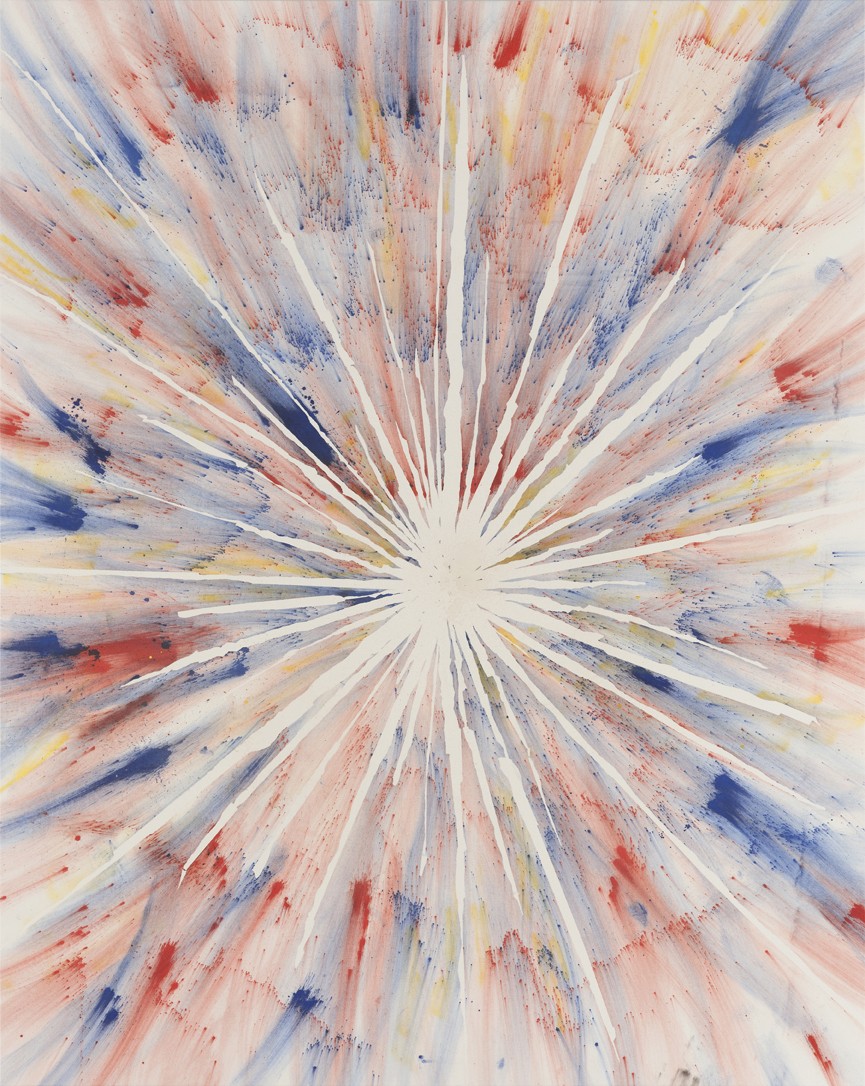
Starburst, 2013, Ink on canvas, 114 x 91 inches. Copyright Harmony Korine. Courtesy Gagosian Gallery. Photograph: Robert McKeever.
You’ve said you like to throw a grenade into a film set to see what will happen. Do you still have that kind of romantic anarchy about filmmaking?
Definitely. It’s also why I love painting, because I can get lost in it. I like not always having an end point and getting lost and trying to dig my way out of it. I like the urgency of it and the constant self-doubt and then, at some point, hopefully being able to pull it together. The process is exciting to me and it is related to the way I make films. I like making movies that are more alchemical. It has to do with this idea of putting different elements into a glass and documenting the explosion. There is a strange poetry to it.
So the ideas, the characters and the narrative all start to bubble up inside this test tube that is your movie set?
Yes. It’s also the way I write scripts, which are only half of what the films become. They contain just the basic idea. I have to raise the money and the actors have to be secured and then the film becomes something totally different in the process of shooting, through rehearsals and locations and costumes, where you are on the day and the range of performances. I stay open to that stuff. I try to stay open to things outside the frame, to the world and how the surroundings affect the story. Then I start to put it together, the same way I make paintings.
But it’s not a collage in that you don’t have all the pieces. You have a sense of discrete scenes but I wonder how those separate scenes add up to some kind of narrative.
I even try to get away from the idea of scenes. They aren’t really specific; I’m after something that is less defined. It’s more like I’m trying to make films riddled with moments. It’s more about energy. In some ways the films are closer to the repetition of images and sound that you would get in electronic-based music.
The music of Skrillex plays a major role in Spring Breakers and in watching the film it occurred to me that your nice sprites evolve into pretty scary monsters by the time the film ends. Did that happen in the shooting or did you have that idea going into the film?
It’s hard to describe the process because there are moments that touch on what you might consider improvisational but they are really not improvised. It is more like a free-form design. It’s things I’ve thought about for a long time, sometimes years, and things that I wanted to do or try, a feeling I had, or a visual picture that I wanted to see. Then I try to make it happen in the moment. So a lot of that stuff happens organically but it is also something I’m thinking about and cajoling a bit. I still think about things in terms of stories and there is narrative; it’s just more of an exploded narrative. I don’t really have any interest in documentary or vérité or improvisational film. I’m trying to get to something different. It’s more like I’m trying to follow the sun.
It does interest me that you worked in the Dogme tradition for a while and took the “Vow of Chastity.” Even in the legendary, unreleased Fight Film you set rules for yourself: you wouldn’t throw the first punch; no one would intervene unless you were in danger of being killed. You were working within a conceptual frame.
Yes. Even before I was with the Dogme brothers, when I was making the fight films and was getting beaten up, it was about the process. Process has always been very interesting to me, and in a lot of ways it is as important as the final product. I was a kid trying to figure things out for myself and I felt the best way to do that was to set restrictions and follow rules.
Did Spring Breakers really come to you in a dream of girls in bikinis robbing fat tourists with guns?
Yes. I had been collecting spring break imagery, which I was thinking of possibly using in some artwork. What I liked in the vision were the colours and the locations and a picture that popped into my mind. I began flirting with the storyline starting with that image and that scene.
You call it a “pop poem,” which suggests that its connections are less literal than atmospheric.
In everything I do atmosphere or tone is as important as any of the characters or any storyline. The way things feel is probably the most important.
Are you good at looking at what you’re seeing and knowing it will feel a certain way for the audience? Did you know as you were making the film that it was going to have the kind of hallucinatory effect that it had?
That was what I was after. As we were watching the film in editing I started to get the sense that this could work, which was exciting because up until that point I wasn’t sure. I had messed around with certain things like that in shooting ads but never in a long-form film, so I wasn’t sure if I was even doing it right.
Do you ultimately find your film in the editing room rather than during the shooting?
Yes, the film is definitely made in editing. I love editing because it is the opposite of shooting. Editing is more controlled. I like trying different versions of the film and different sequences. I can deconstruct it; I can pull it apart; I can add or subtract storylines; I can loop things; I can enhance certain things that weren’t in the script; I can take things away that I didn’t like. It’s where everything happens.
There is a pair of remarkable scenes that didn’t make it into Julien Donkey–Boy, particularly the one where Julien invents this mad narrative for a psychiatrist.
I love that scene. There are a lot of scenes like that which are almost their own thing, like the sequence where he goes to the confessional. We hooked him up with hidden spy cameras and he was in there confessing this stuff and it was such a heavy scene. Scenes like that are almost their own movie, their own kind of moment. They are so radical that you can’t get over them and you can’t get back into the film because they become a distraction. In the end there is that thing, that you have to kill your babies.
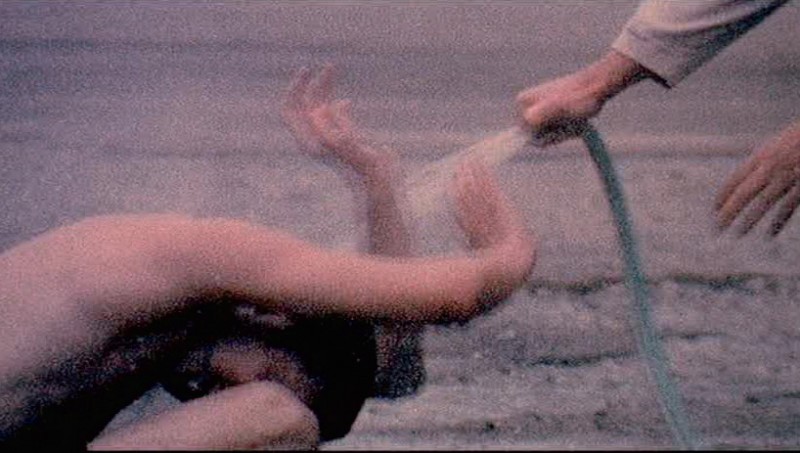
Julien Donkey-Boy, film stills, 1999, 100 minutes.

Julien Donkey-Boy, film stills, 1999, 100 minutes.
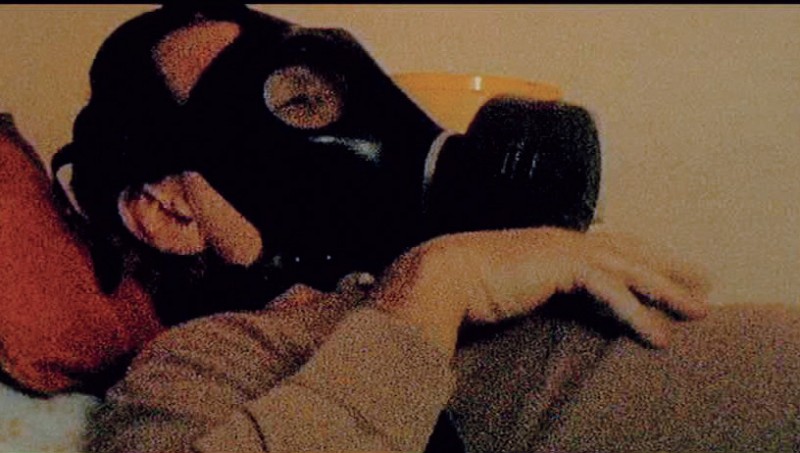
Julien Donkey-Boy, film stills, 1999, 100 minutes.

Julien Donkey-Boy, film stills, 1999, 100 minutes.

Julien Donkey-Boy, film stills, 1999, 100 minutes.

Julien Donkey-Boy, film stills, 1999, 100 minutes.
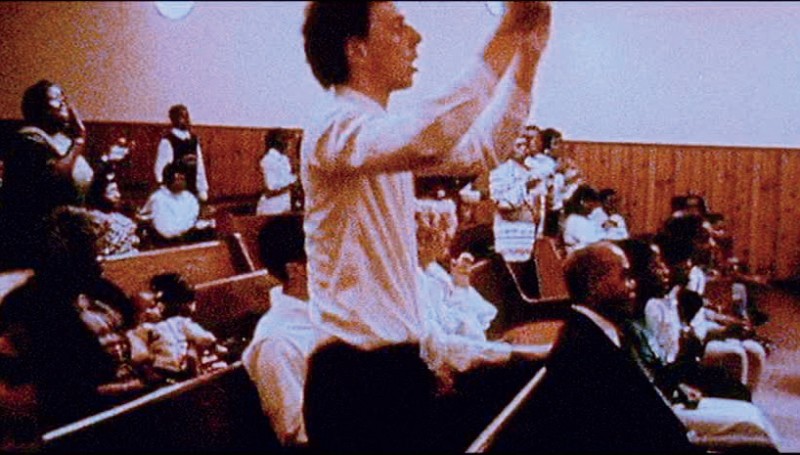
Julien Donkey-Boy, film stills, 1999, 100 minutes.

Julien Donkey-Boy, film stills, 1999, 100 minutes.

Julien Donkey-Boy, film stills, 1999, 100 minutes.

Julien Donkey-Boy, film stills, 1999, 100 minutes.
In Julien Donkey–Boy the wrestling scene is one of the most fascinating. Julien is dressed in his shorts and a bra and he fights only half-heartedly with Chris, so that by the end, no one is satisfied with how it turns out. That scene seems self-contained to me but then you have to get him outside so that he can try and reconcile with Chris. Was that a natural place for you to go after the emotional intensity of the screwed-up fight scene?
I was pretty messed up when I was making that movie, so it’s difficult for me to remember. There wasn’t any kind of conventional script. It was just a series of ideas or narrative sketches. The script was more like descriptions of photographs, things that you would see, and then I would base the sequences around these moments or descriptions. It’s like anything; one thing leads to another, an actor does something you don’t expect and goes in some other direction, and you follow it if you can and you see where it goes.
Did you really shoot two-thirds of Gummo on the final day of filming?
Two-thirds is a bit of an exaggeration. But we probably shot 10 minutes of the film on the final day. It was a 24-hour day because I had been waiting for rain for the whole movie. It was insane but when I think about it, the things we shot on that day are probably the best things in the whole movie.
Was it Julien Donkey–Boy that precipitated the dark night of the soul you went through? What happened to you?
I had been making art and movies since I was in high school and success came to me at a pretty young age. I was at a point in my life where something changed. I was like a kid, I was out there and I was lost. I was making it up. I wanted to be great and I wanted it all. But I was also full of anger and wanted to explode the whole fucking thing, and at that point I hadn’t built any kind of buffer. I didn’t think I was going to live that long and I wanted to cram as much as I could into a short period of time. I wanted it all to be dazzling and to fuck it up. And I went for it and sometimes things get murky. At that point everything in my life started to feel the same, the movies and the artwork and my writings and my actions in private. My whole life was all blended up. Things become the most dangerous when you don’t know where the stage is. You have to know when you’re performing, where the stage is and how to cut it off and disappear. I didn’t really know and I was also having fun. I grew up in the South in a culture of skateboarding at a time when rednecks were coming after me and I was getting into fights every day. It was great but it also gave you a sense that there was a sinister vibe in the atmosphere. There are fuckers lurking in the shadows. So I was coming out of that and I retained that mentality. It’s a kind of aggression that you welcome and go for and you just put it back into the world.
It isn’t simply that you grew up in that world but you have remained attracted to really obsessive characters, outliers, people who are inventing themselves all the time. A lot of people would describe them as abject characters but you don’t see them that way. You don’t make judgments about them.
I try not to. I’ve never understood weird power trips where people invent characters only to judge them. It’s a strange thing. I was always more into presenting things and letting the chips fall. As far as the characters go, it is just who attracts you, what you know, and what you’re drawn to. I grew up where Gummo was filmed, so it was pretty familiar. At the same time, I hadn’t seen it in movies, so it was something I wanted to show.
David Salle says that the reason he paints what he does is because he wants to see something he has never seen before. I guess that is a pretty compelling idea. You don’t replicate a world that already exists; you search for a world to make?
Right. And it is important to repeat that I don’t have any interest in vérité. My movies are not documentaries; they’re not exposes. They’re not based on this idea of truth in film. None of the art I make is based on truth. I’m trying to get to something that has to do with a kind of transcendence, or an energy, or some kind of fucked up vapour. I want it to work in a physical way. It’s closer to a specific type of poetry than any type of truth. Truth is boring. I don’t care about truth.
In the two films in which Werner Herzog appears, as a drunken priest in Mister Lonely and as the tyrannical father in Julien Donkey–Boy, I can’t tell if he’s playing a role or if he’s simply being Werner Herzog.
All the characters are shaped. Again, it’s never any one thing, it’s every thing, so you can’t even begin to know where he begins or where any of these characters begin and where they end. It’s everything and nothing.
You worked hard, though, with Ewen Bremner, to get the cadences of your Uncle Eddy’s speech patterns. The viewer can recognize that his inspired portrayal as Julien is less an accident of acting than the application of acting technique.
Yes. If I remember correctly, Ewen was really obsessive about that role. He would visit my uncle in the mental institute and would actually record how my uncle sounded. I remember seeing him one day, he was living at my grandfather’s house and he was sweeping the front steps. He had headphones on and I asked him what music he was listening to. It wasn’t music; it was my uncle babbling about the fact that Frank Sinatra was trying to kill him. Ewen listened to these recordings for days and days. It was real devotion to the role.
How did the character of Alien, played by James Franco, evolve in Spring Breakers? You seem to be more interested in Alien’s world, the trap houses and the faded yachts, than the world of the spring breakers. What made it more attractive?
It’s more exciting. The girls are coming from mainstream, adolescent mall culture and the film was about this journey, this small step into the underworld. Alien was a kind of shadow creature. I liked the idea of them entering and transcending his world and becoming harder and even more treacherous and refined than anything he imagined.
The girls do out-distance Alien, don’t they? They really go for it and the transformation in the film is that they’re in control of what’s going on.
Totally. That’s what the film was about.
The twins that Alien works with remind me of the pair of drooling brothers in the photographs of Roger Ballen. The brothers in your film are a little bit spooky.
They’re meant to be. They’re like that in real life, too.
In Milton’s Paradise Lost the devil is considerably more attractive than Christ. He was trying to write an epic that praised God but he ended up writing one that celebrated the devil. Is that a natural thing to happen when you’re telling a story?
The dark side is more attractive. But it also has to do with the fact that in the films I’m trying to show that there isn’t really a good guy and a bad guy, that they are all kind of both. There are obviously levels to the characters but even with the gnarliness of the twins in the film, there is also something amazing about them. That’s the case with all the characters. I don’t want you to feel only one way about them. Personally, I never feel one way about anything. So the characters are never all the way evil or good. In general, the more messed up they are, the more fun it is to watch them.

Gummo, film still, 1997, 95 minutes.
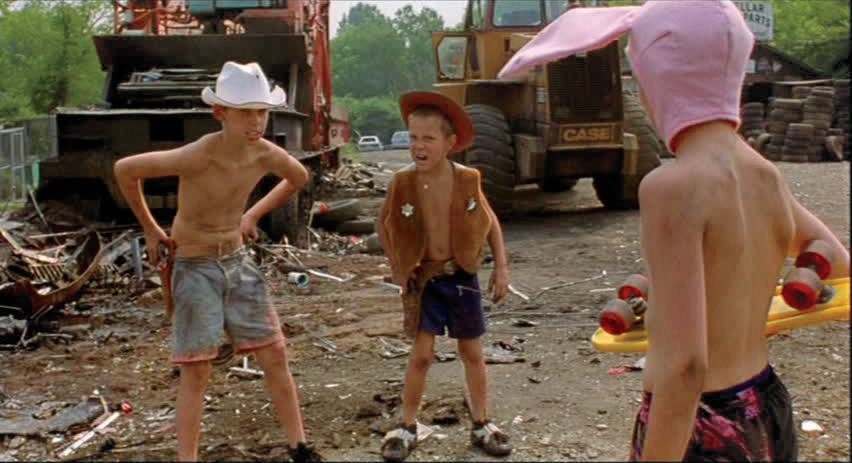
Gummo, film still, 1997, 95 minutes.
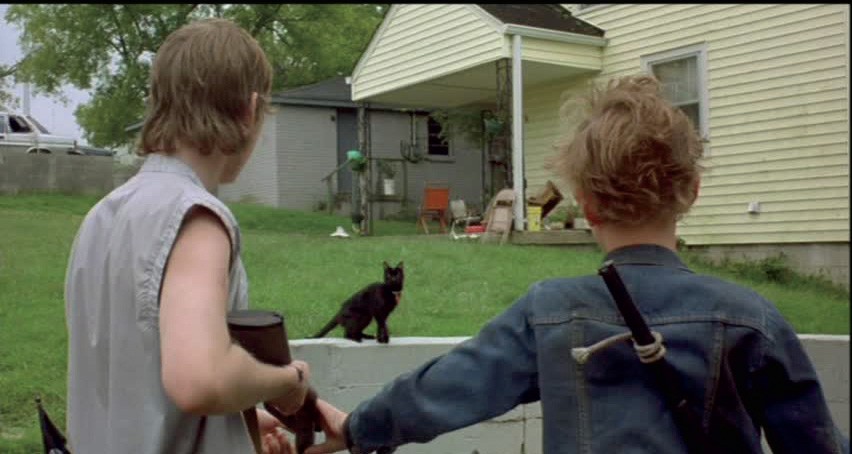
Gummo, film still, 1997, 95 minutes.

Gummo, film still, 1997, 95 minutes.
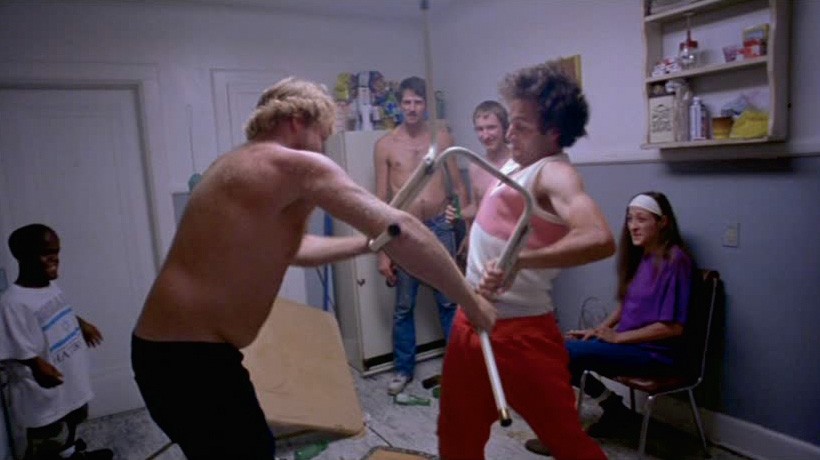
Gummo, film still, 1997, 95 minutes.

Gummo, film still, 1997, 95 minutes.
The film that confuses me the most is Trash Humpers. For the first 10 or 15 minutes I wasn’t sure I could watch it, or that I was interested enough to stick with the story. But those guys get inside your psyche and I’ve not been able to get them out of my head since. And aren’t you one of the trash humpers?
Yes.
Are you the guy throwing the tiny firecrackers around?
That’s not for me to say.
Were you pushing as hard as you could to make characters who didn’t have any redeeming qualities? I accept that life isn’t a melodrama, but among your films these guys get closest to that state.
They’re almost artists in a way. I viewed them as poets of horror and mayhem. They elevate evil in a way that that makes it almost great. It’s the vernacular of delinquency; their only language is delinquency, it’s all they know. They live in terms of opposites; they’re not up during the day, they’re only around at night, they cheat to get what they want, they only ever steal to get what they need. There’s a kind of beauty and a joy to how messed up they are and to the places where they go. But they do have a philosophy attached to what they do. They’re shape-shifters, real shadow creatures.
You have said that to go after real greatness you have to experience life as if you were a criminal, so Jean Genet would be a patron saint within their universe. In some ways, these guys live like criminals.
Yes and even the word criminal is not a purely literal reading of the way they are; it is just a thought process. There is a criminal thought process that I think definitely benefits the artist.
And it isn’t about breaking certain conventions of law. It’s about violating what society determines is appropriate and tasteful behaviour.
Also, it’s not interesting to me if it doesn’t hurt a little bit.
Your view is that hurt is universal, but so is making people laugh. One of the things about your films that goes unremarked is that they are terrifically funny.
I think that a lot of them are comedies.
In the way that you regard the Fight Film as Buster Keaton crossed with a snuff film? Is there anything you won’t do in a film?
I don’t really know. I never put limits on anything. I’m not really worried about it because I know my intentions are pure.
On the subject of intentions, were you serious when you said that Gummo would be embraced by audiences in the way Bambi had been?
I did think it would play in shopping malls. I guess at that age I was more delusional and still dreaming in a lot of ways. I did feel it would be close to a movie like Bambi or E.T., or even something like Porky’s. I thought it would be part of that lineage.
The film that does have a lot of dreaming is Mister Lonely, which I found quite poignant. It seemed a different kind of film for you and I wonder what was it about the story that attracted you?
Well, all my movies are a reflection of who I was at the time of making. I had just come out of a long darkness and I was trying to create something that I believed in. I was intrigued by the idea of celebrity impersonators, Michael Jacksons and Marilyn Monroes and Sammy Davis Jr.’s, and by people inventing a completely alternate identity. Having grown up myself in a commune, I thought a commune full of impersonators was a pretty funny concept. So I wrote it with my brother.
When Samantha Morton says to her husband, a Chaplin impersonator, that sometimes he reminds her more of Adolf Hitler than Charlie Chaplin, it is a weighty line.
You have the public persona of the impersonator and it’s always the person they are impersonating, but I wanted to invade their private world as well. I liked the fact that there was also the mythology of the character and then there was an actual person at the commune. My interest was in trying to blend them.
Were you more interested in beauty than you had been in your other films?
The way I was feeling at the time I was probably trying to move in that direction.

Frost Ball Jr High, 2014, oil, latex house paint and collage on canvas, 43.75 x 38.75 inches. Copyright Harmony Korine. Courtesy Gagosian Gallery. Photograph: Robert McKeever.
In one way the film is about dreaming in the shadow of life’s fragility, with the killing of the sheep herd, Marilyn’s suicide and the plane crash with the dead nuns. Was the film about some kind of personal reclamation for you because you had come through that dark night of the soul? It seems a hopeful film.
It probably had something to do with that. It was meant to be hopeful.
The other story in the film is about the flying nuns. How did that play into the narrative of the commune and its celebrity impersonators?
I thought the two stories were parallel. The flying nuns story was tangentially tied to the main story, almost like a poetic punctuation. People are used to seeing things that are obviously tied up and I was trying to make a film that was opposite to that. For me, the relationship between the two storylines had to do with an emotional idea of transcendence, an “If you believe it, it will happen” kind of thing.
The flying nuns sequences, and especially the one with the figure and his bike, are lyrically beautiful. Were those difficult shots to get?
That was one of the most difficult things because there was no CGI. And the guy who rode the bike almost died when we shot it. He went into a tailspin and blacked out and it got pretty insane. There was a parachute, which we painted out frame by frame, so that one shot took a couple of months. That sequence is beautiful and hypnotic but when I watch it I realize that the guy on the bike spinning in the air is unconscious.
What is it about nuns and you? Why’s a nice boy like you dreaming about nuns so often?
When I was a kid I had a best friend who used to bone two or three nuns for car parts. He was a Latino gang-banger who was really into low-riders and stuff, and the nuns would buy him rims for his car. He was always really complimentary about them. I don’t know, I just thought nuns were intriguing characters.

Pajama Reststops, 2014, house paint, acrylic and oil on safety blanket, 64 x 70 inches. Copyright Harmony Korine. Courtesy Gagosian Gallery. Photograph: Joshua White.
The only other filmmaker who has seen nuns in an erotic way is Luis Buñuel, who realized that since nuns are married to Christ, they were inclined to get it on with the godhead. But yours is a whole new take.
Well, there is a lot of weird shit going on.
But you don’t make films to capture weird shit, do you? You’ve described yourself as an American filmmaker and the thing about American storytellers is that they consistently attach a moral to their tales. Are you in that American tradition? Is there a lesson to be learned from your films?
I have said that I am the most American director of all time. Or at least I’m up there with John Ford and Clint Eastwood as far as my Americanism is concerned. I think at a certain point that will become apparent to everyone.
But my reading of American stories is that there is story is some lesson to be learned. Are you prepared to go that far?
I don’t know. My films aren’t about lessons. I never really learned that much.
All the time that you’re making films aren’t you learning more about what you’re doing? In the same way that when you go into your studio, you learn more about making a painting.
That happens through doing. The more you do something, the more you learn about it, the more it becomes second nature. But again, it’s not really learning; it’s a physical thing. It’s the process I’m after.
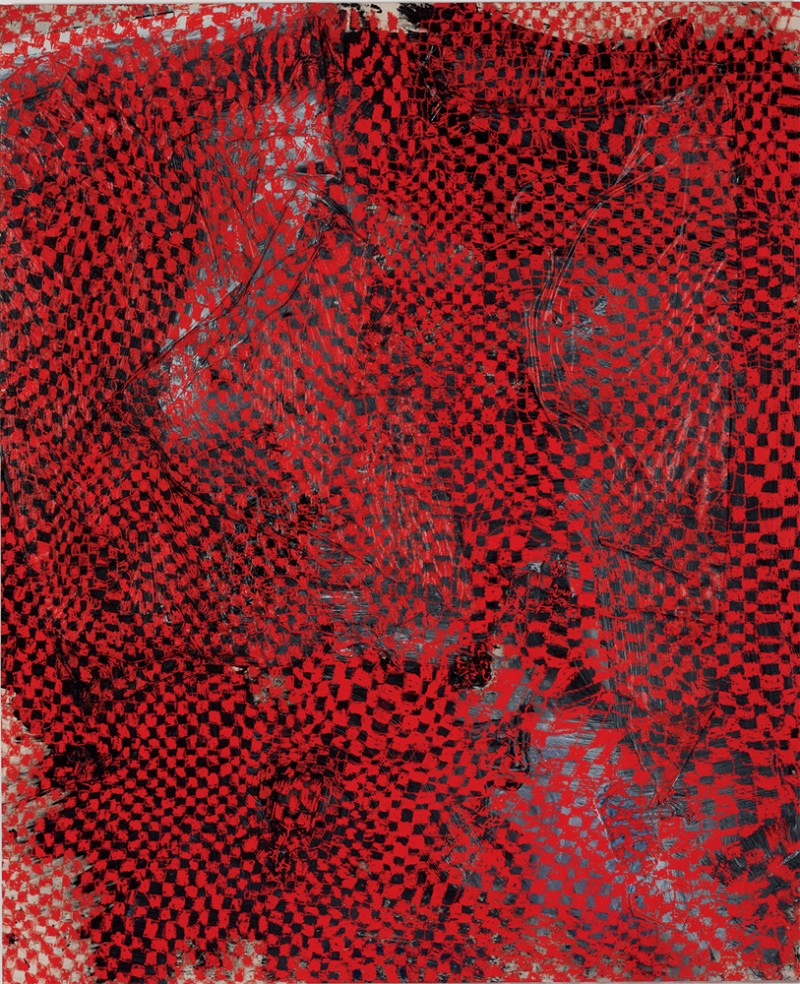
Special Needs Chex, 2014, house paint, oil and collage on canvas, 102 x 84 inches. Copyright Harmony Korine. Courtesy Gagosian Gallery. Photograph: Joshua White.
As a viewer do you want me to enter the process, or am I entering some kind of narrative?
Both those things. In the end, I just want you to be entertained. That’s the truth. I want the experience to be pure entertainment but entertainment can come in a lot of different ways.
You talk about the strange insanity of what Buster Keaton, Al Jolson and WC Fields could do and that you couldn’t figure out how they existed. Do you want to get that same strange insanity in the work you do in film?
There was just a deep and eternal poetry to those guys. They had this weird inner logic; you can’t imagine them ever inventing themselves, or you can never imagine them being born, but you can also never imagine them dying.
What was it about Keaton’s Steamboat Bill Jr. that drove you into filmmaking?
I wanted to figure it out; I wanted to figure out how to get there.
Movement and dance seem especially important to you. They come up often enough to be a kind of visual touchstone in the films.
I love dance and movement. It is awesome to watch people dance, especially if they’re not self-conscious about it. Last night in Miami I went to this outdoor reggae DJ thing and there was this guy, I don’t know if he had Down Syndrome, but he looked like he did. He was dancing with a cigarette, dancing while he was smoking. It was unreal. He went up to every black dude and every Jamaican guy and gave them a hug. Then he would smoke this cigarette and dance like a fat worm. It was awesome because he was so in the zone. Sometimes you just want to be in the zone like that.

Blue Checker, 2014, oil on canvas, 102 x 84 inches. Copyright Harmony Korine. Courtesy Gagosian Gallery. Photograph: Robert McKeever.
You’ve said film is the most complicated of the art forms you practise. Do you still regard it that way?
Yes. When I say complicated it’s not the act of making a movie. Obviously there are complications in the creativity as well, but it is the bureaucracy of filmmaking that I can’t stand. It’s why I like painting now. It is difficult for me to be around that many people. I don’t like how corporatized film has become but it’s also something I don’t like to spend time complaining about because it is what it is. I love making films and I also love it if people enjoy the final product enough for them to have an effect.
In Spring Breakers, Alien says the American dream is about making money. Maybe it’s about self-invention with as few impediments as possible. You’ve said your greatest talent might be that you’re inventing yourself as you go along. Is that your American dream?
That, and some good pussy.
I want to shift to a different kind of skin. In your paintings, do you distinguish between the work that is spookily figurative, like Frost Ball Jr. High and Prince Gravel, and work that is more patterned and abstract, like Skinamax Chex and Fex Chex?
There are different paintings and different groupings, so the line paintings and the Chex paintings are more like trance paintings. There is repetition of colour and pattern. Those ones are not pure abstraction or figuration. I’m trying to have them meet somewhere in the middle. The figurative works and the line paintings are more an interplay between the two. One is about the world and the other is about characters who inhabit the world.
There are figures literally under the surface in paintings like Bacc Rox Line and Pep Cubbie Line Painting.
That’s what I mean. If you look closely those things are there but if you don’t look that closely, they’re still there. There are characters and figures and stuff that start to bubble up under the surface. It’s repeating until things begin to happen, until the energy seems to come from below the surface, until shadows become manifest.
You have said that if people look at your films, they’ll understand more about you than if you tell them about yourself. Is that also the case with the paintings?
Of course, because it is all about the same thing. It’s not about answers. It’s about what it is. In a lot of this stuff there is always a margin of the undefined.
I thought your suicide notes in A Crackup at the Race Riots were very poignant. They break your heart and make you laugh at the same time.
Those things are in every thing I try to do. ❚
Interested in seeing photos from the Launch Party for this Issue? More here.

Scubby Line, 2014, house paint, oil and collage on canvas, 124 x 93 inches. Copyright Harmony Korine. Courtesy Gagosian Gallery. Photograph: Joshua White.

